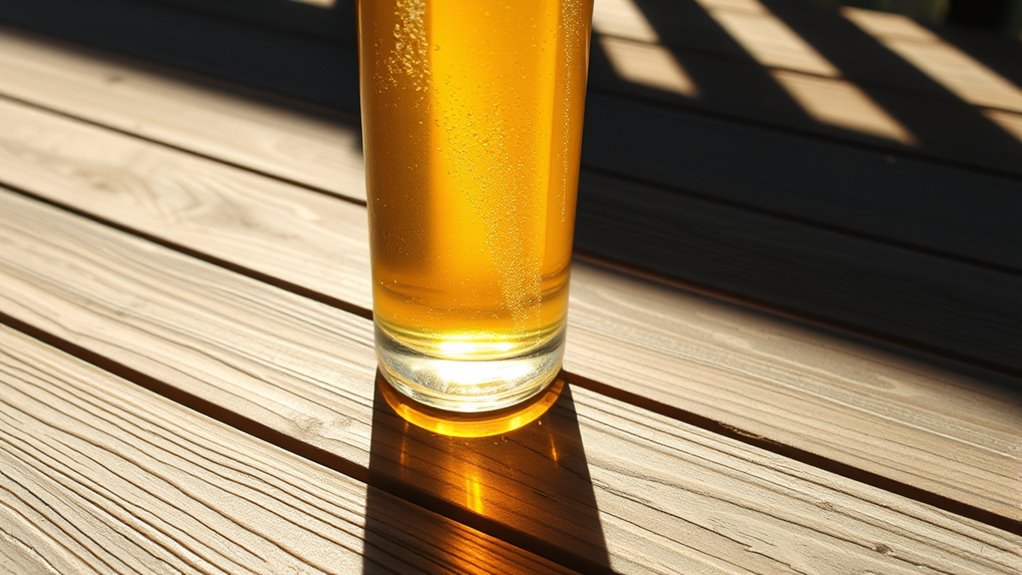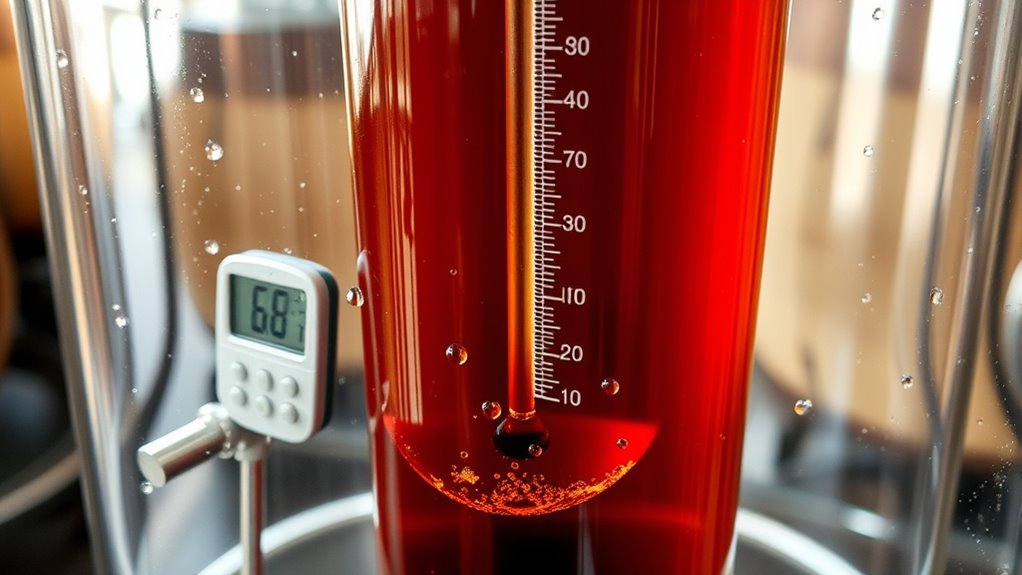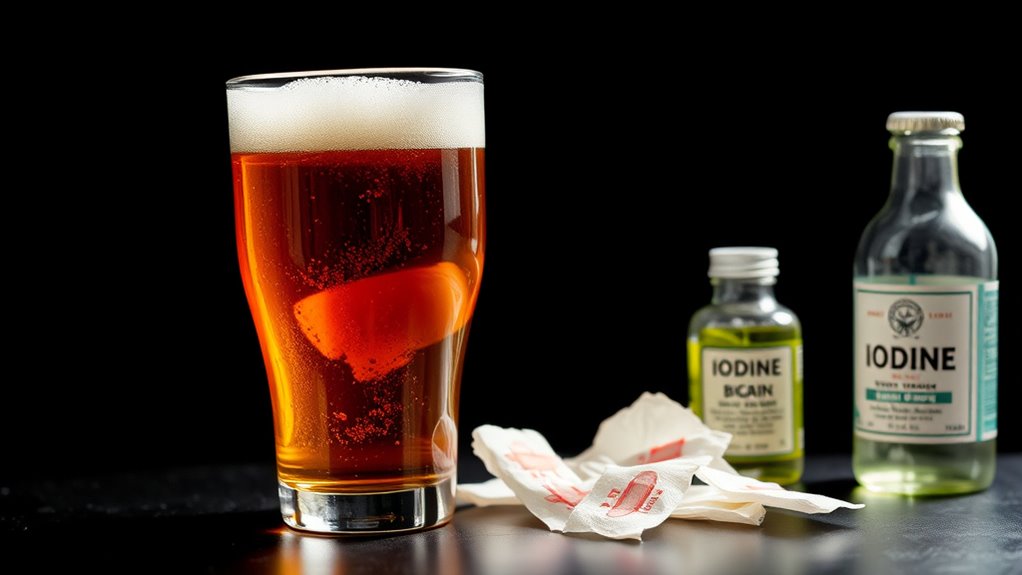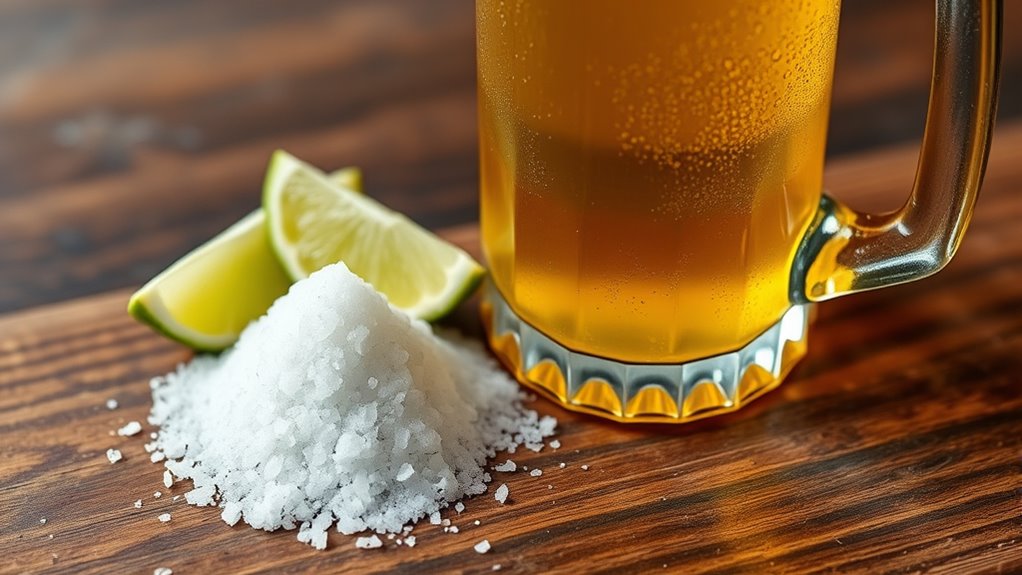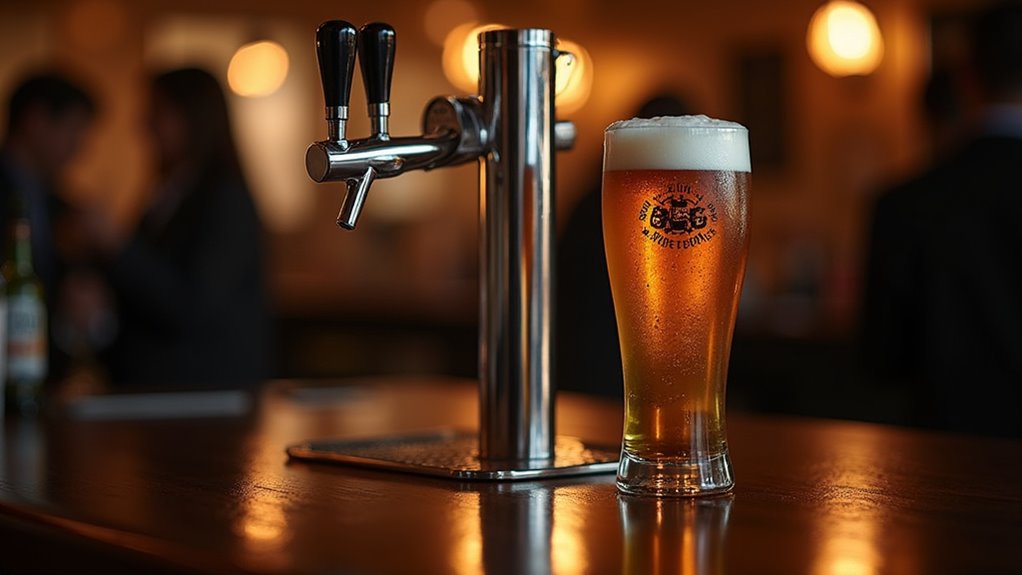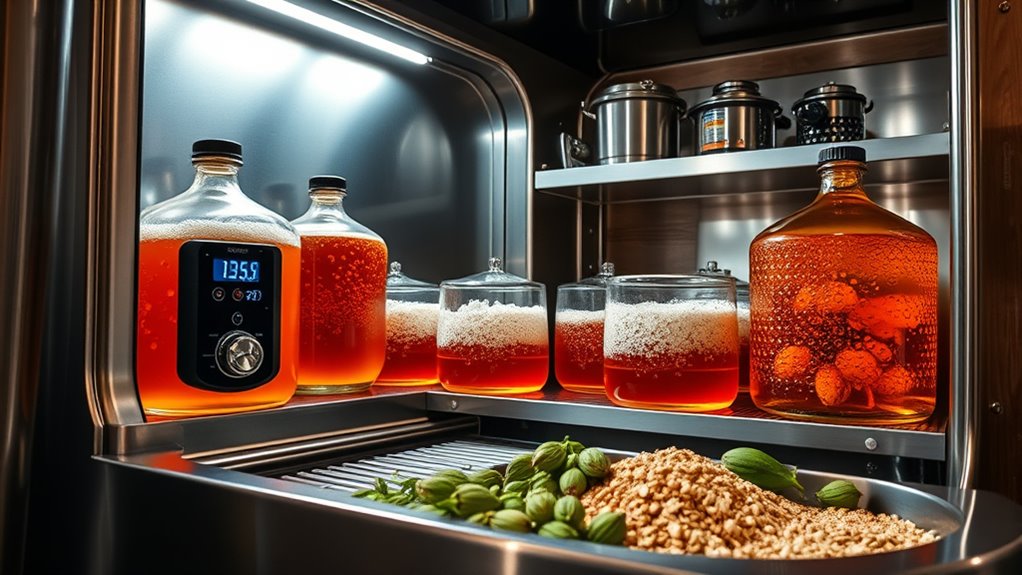Skunky flavors in beer occur primarily when UV light hits the brew, causing a chemical reaction. This reaction transforms hops into 3-methyl-2-butene-1-thiol (MBT), which smells like skunk spray. Clear and green bottles let in harmful light, whereas brown bottles offer better protection. To avoid this, store your beer in dark, cool places and use opaque containers. For more tips on preventing these off-flavors, you’ll find useful strategies just ahead.
At a Glance
- Skunky flavors develop when UV light exposes beer, triggering chemical reactions that alter its flavor profile.
- Isohumulones from hops convert into 3-methyl-2-butene-1-thiol (MBT) under light exposure, responsible for the skunky aroma.
- Clear and green bottles are especially vulnerable to light, leading to quicker development of undesirable flavors.
- Even brief exposure to sunlight or fluorescent light can cause noticeable skunkiness within seconds.
- Storing beer in dark, cool places and using brown bottles can significantly reduce the risk of light-struck flavors.
Understanding Skunky Beer and Its Characteristics
Skunky beer is a common problem that many beer drinkers encounter, and it’s vital to recognize its distinct characteristics.
Light-struck beer develops a skunky aroma due to exposure to UV light, which transforms isohumulones from hops into a compound that smells like skunk spray. This undesirable flavor can manifest quickly, often within seconds of sunlight contact.
The packaging plays an important role; clear bottles are most susceptible to skunkiness, while brown bottles provide better protection. To maintain quality, store your beer in a dark, cool place and choose packaging wisely to avoid those unpleasant, moldy flavors.
Helpful Hints:
- Opt for brown bottles.
- Store beer away from light.
- Check for off-aromas before drinking.
The Role of Light Exposure in Beer Skunking
When beer is exposed to light, particularly ultraviolet (UV) light, a chemical reaction occurs that can drastically alter its flavor profile.
This light exposure breaks down isohumulones in hops, creating 3-methyl-2-butene-1-thiol (MBT), which gives beer its skunky aroma. Clear and green beer bottles are especially vulnerable, as they don’t effectively block UV light.
Even brief exposure to sunlight can lead to noticeable skunky flavors within seconds. To prevent this, store your beer in dark spaces or use opaque containers.
Helpful Hints:
- Choose dark beer bottles.
- Avoid direct light exposure.
- Store beer in cool, dark places.
Chemical Reactions: From Hops to Skunky Flavors
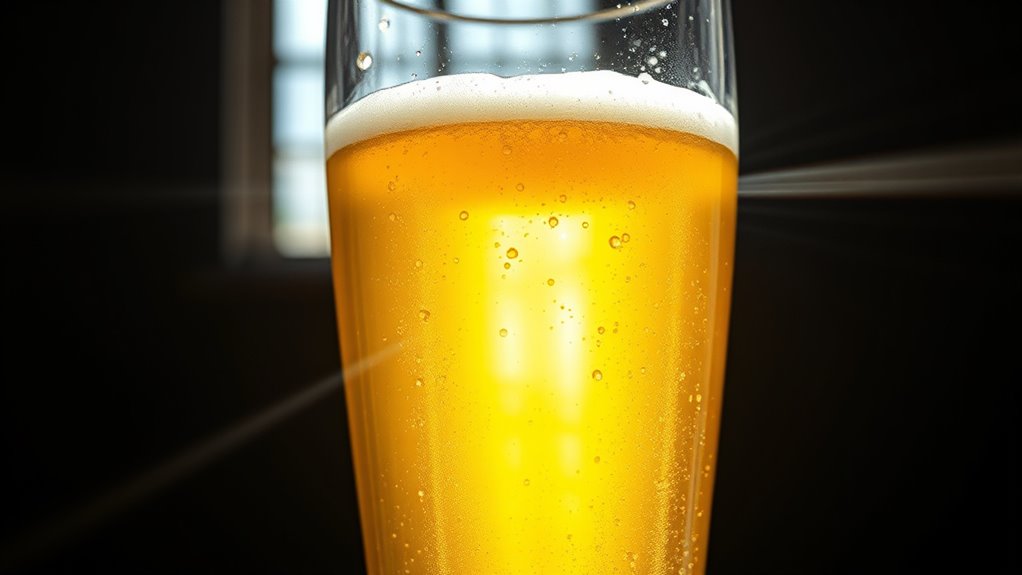
Understanding the chemical reactions that lead to skunky flavors in beer is essential for anyone looking to enjoy a fresh, flavorful brew.
When hops are introduced to beer, they create isohumulones, bittering compounds. However, light exposure, especially UV light, triggers a rapid transformation into 3-methyl-2-butene-1-thiol (MBT), the compound responsible for skunky beer. This reaction can happen almost instantly under direct sunlight or fluorescent light.
Additionally, riboflavin amplifies this sensitivity, increasing the risk of developing undesirable flavors. To avoid skunkiness, store beer in dark brown bottles or cans and keep it away from light whenever possible.
Helpful Hints:
- Store beer in cool, dark places.
- Choose darker packaging for better protection.
Packaging Choices: How Bottle Color Affects Skunking
The color of the bottle you choose can greatly impact the freshness and flavor of your beer. Here’s how different bottle colors affect skunking:
The bottle color you select significantly influences your beer’s freshness and flavor, affecting its susceptibility to skunking.
- Clear Bottles: Provide no protection against UV light, making your beer highly susceptible to skunky flavors.
- Green Bottles: Offer minimal protection, still leaving your beer at risk of developing off-flavors.
- Brown Bottles: Effectively block UV rays, considerably reducing the likelihood of light-struck flavors.
Innovative breweries have switched from clear to brown bottles after consumer feedback emphasized avoiding skunky beer, highlighting how packaging choices directly influence quality and consumer perception. Proper bottling practices, including clean, sterilized bottles, are essential for preserving beer flavor and preventing contamination.
Choose wisely for ideal flavor.
Storage Conditions: Preventing Light Exposure
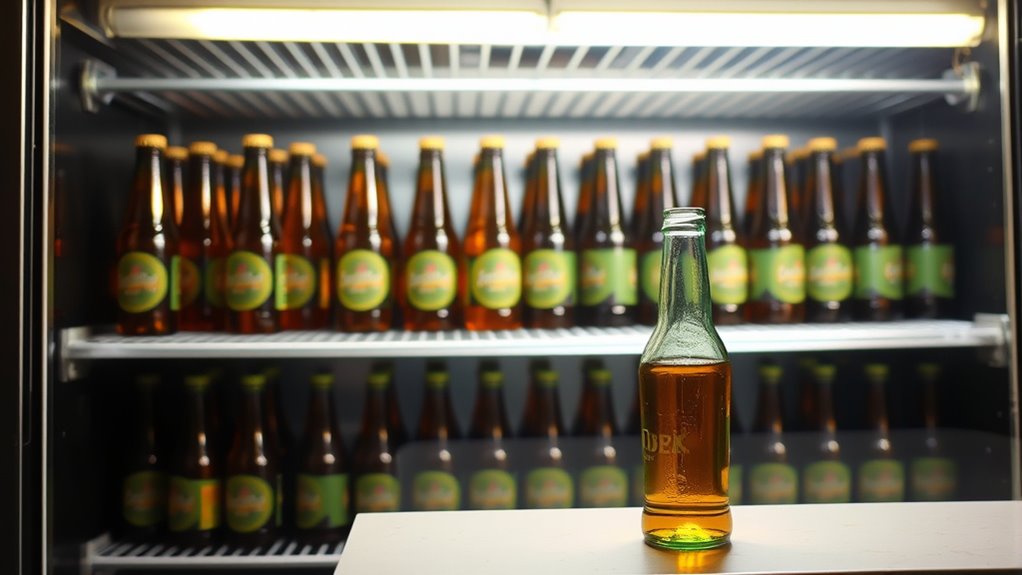
To maintain the quality and flavor of your beer, it’s important to contemplate storage conditions that minimize light exposure.
Store your beer in a dark box or cabinet, away from sunlight and UV light sources. Using opaque bottles, like dark brown ones, offers superior protection against harmful light, ensuring your brew stays fresh.
When serving outdoors, keep your beer in a closed cooler to limit exposure. Regularly inspect your storage areas for potential light sources, and avoid fluorescent lighting during transit.
If you’re homebrewing, wrapping clear fermentation vessels in blankets can also shield them from light during fermentation and aging.
Homebrewing Tips to Avoid Skunky Flavors
When brewing your own beer, it’s essential to take steps that prevent skunky flavors from ruining your hard work.
Here are some helpful tips:
To ensure your beer maintains its flavor, keep it in the dark and use brown bottles for storage.
- Store fermenting beer in dark spaces to avoid light exposure, as even brief sunlight can initiate skunking.
- Wrap clear vessels in blankets or brown paper bags for added protection during fermentation.
- Use brown bottles for bottling instead of green bottles, which are more susceptible to skunky flavors.
- Ensure vigorous fermentation by pitching fresh, healthy yeast, as this helps minimize off-flavors and reduces the risk of contamination from wild yeast strains.
Distinguishing Light-Struck Beer From Other Off-Flavors
Distinguishing light-struck beer from other off-flavors requires a keen understanding of its unique characteristics and how they differ from other common issues.
Light-struck beer typically has a mild skunky or sulfur aroma, resulting from light interacting with hop compounds. This contrasts with off-flavors like DMS or oxidation, which have distinct scents.
Misidentification can occur, so sensory training is essential for accurate detection. Light-struck flavors can develop at various stages, making monitoring vital.
To enhance your skills, consider participating in off-flavor training panels, which can help you learn to identify and distinguish light-struck beer from other off-flavors effectively.
